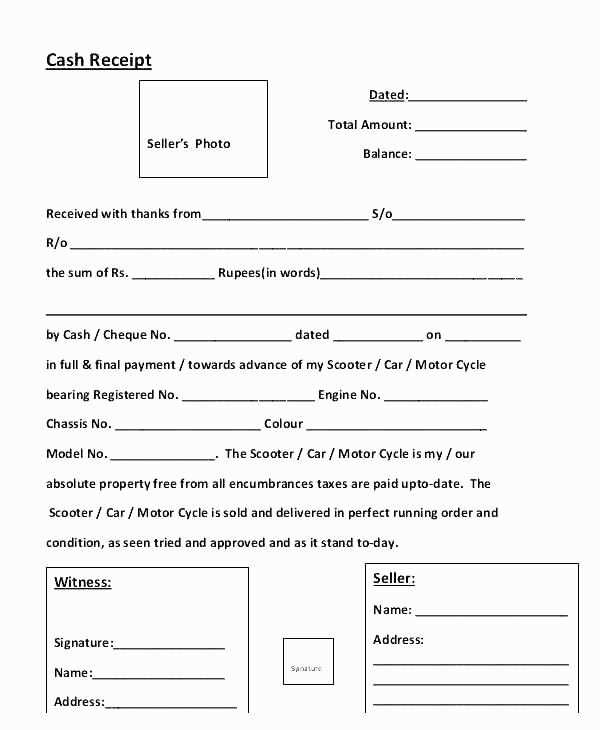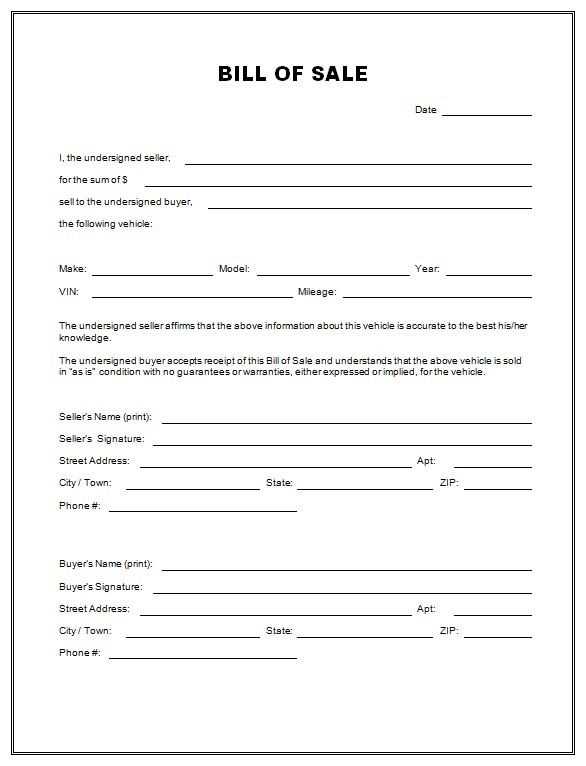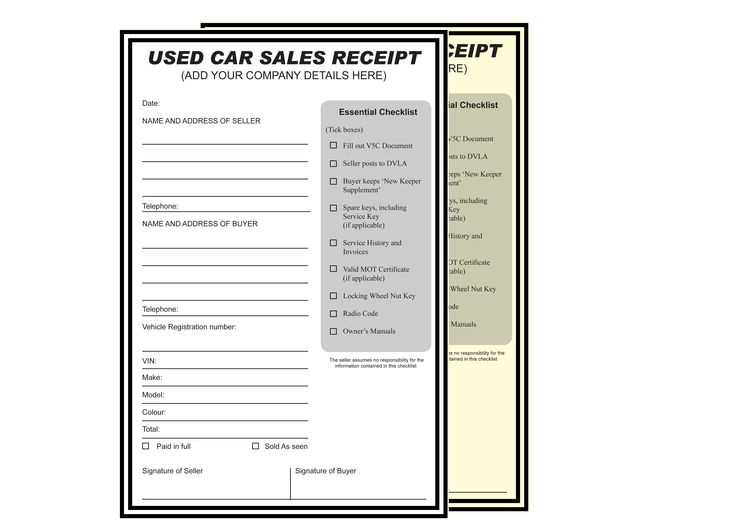
Always document the sale of a used vehicle with a signed receipt. A “sold as seen” agreement helps protect both buyer and seller by confirming that the car is sold in its current condition, without warranties or guarantees. This is especially important in private sales where consumer protection laws may not apply.
A proper receipt should include the full names and addresses of both parties, the date of sale, vehicle details (make, model, year, VIN, and mileage), and the agreed price. Adding a statement like “sold as seen, tried, and approved by the buyer” reinforces the seller’s position in case of disputes.
Both parties should sign and retain a copy of the document. This prevents misunderstandings and provides proof of the transaction. While a handwritten receipt is acceptable, a printed template ensures all essential details are covered. Below is a structured example that you can customize for your sale.
Sold as Seen Car Receipt Template
A “Sold as Seen” car receipt protects both buyer and seller by confirming the vehicle’s condition at the time of sale. Ensure the document includes all critical details to prevent future disputes.
- Buyer and Seller Details: Full names, addresses, and contact information.
- Vehicle Information: Make, model, year, registration number, VIN, and mileage.
- Sale Price: Clearly state the agreed amount and payment method.
- Condition Statement: A clause confirming that the buyer accepts the vehicle “as is,” without warranties or guarantees.
- Date and Time: Mark the exact moment of ownership transfer.
- Signatures: Both parties must sign to acknowledge agreement.
Handwritten modifications can lead to misunderstandings. Use a pre-typed template to maintain clarity. Always provide copies for both parties to ensure records are available if needed.
Key Legal Aspects of a Sold as Seen Agreement
A “sold as seen” agreement transfers responsibility to the buyer, but it does not eliminate all legal obligations. The seller must provide accurate information about the vehicle’s condition and must not misrepresent any details. Hiding known defects or providing false information can result in legal disputes.
Liability for Misrepresentation
The seller cannot legally mislead the buyer. If a defect is deliberately concealed or false claims are made about the car’s history, the buyer may have grounds for legal action. Written records of all disclosures protect both parties and reduce the risk of disputes.
Private Sales vs. Dealer Sales
A private seller is not bound by consumer protection laws in the same way as a dealer. However, any fraudulent statements can still lead to liability. Dealers, on the other hand, must comply with stricter consumer rights regulations, even if the car is advertised as “sold as seen.”
Clear documentation is key. The receipt should state that the buyer has inspected the vehicle and accepts it in its current condition. Adding a clause confirming that no guarantees or warranties are provided helps prevent misunderstandings.
Mandatory Information to Include in the Receipt
Clearly state the full names and addresses of both the buyer and the seller. This ensures transparency and provides legal clarity if any disputes arise.
Specify the make, model, year, vehicle identification number (VIN), and mileage of the car. These details uniquely identify the vehicle and prevent any misunderstandings.
Indicate the date and time of the sale. A precise timestamp helps establish when ownership changed hands.
List the agreed-upon price and payment method. If the payment is made in cash, explicitly state this to avoid later disputes.
Include a clause confirming that the vehicle is sold “as seen,” meaning the buyer accepts the car in its current condition without warranties.
Both parties must sign and date the receipt. Signatures finalize the transaction and serve as proof that both the buyer and seller agreed to the terms.
Step-by-Step Guide to Drafting the Document
Clearly outline the sale terms to prevent disputes. Include essential details in a structured format to ensure clarity and legal soundness.
Essential Information to Include

| Section | Details |
|---|---|
| Buyer & Seller Details | Full names, addresses, and contact details of both parties. |
| Vehicle Information | Make, model, year, VIN, mileage, and registration number. |
| Sale Price | Final agreed amount, payment method, and date of transaction. |
| Condition Statement | Confirmation that the car is sold “as seen” with no warranties. |
| Signatures | Both parties must sign and date to confirm agreement. |
Formatting and Language Tips

Use clear, concise language without ambiguous terms. Avoid unnecessary details that may cause confusion. Ensure the document is printed in legible font size with enough space for signatures. A witness signature can provide additional security.
Common Pitfalls and How to Avoid Them

Failing to document the car’s condition leads to disputes. Take clear photos of the vehicle from all angles, including the interior, and attach them to the receipt. Note any existing damage in writing.
Leaving out buyer and seller details makes the receipt legally weak. Include full names, addresses, and contact information to prevent misunderstandings.
Omitting the “sold as seen” clause can create liability issues. Clearly state that the buyer accepts the car in its current state with no future claims against the seller.
Ignoring payment details opens the door to fraud. Specify the exact amount paid, payment method, and date. If using cash, both parties should sign to confirm receipt.
Not keeping a copy of the receipt is a common mistake. Both buyer and seller should retain signed copies to avoid future disputes.
Printable and Digital Receipt Formats
Choose between printable and digital receipts based on convenience and legal requirements. A well-structured format ensures clarity for both buyers and sellers.
Printable Receipts
A printed receipt must include essential details: buyer and seller information, vehicle details, sale price, payment method, and date. Use a clear, legible font and standard paper size (A4 or Letter). A signature line confirms agreement, and carbon copy paper allows instant duplicates.
Digital Receipts
For a digital format, create a PDF file to maintain formatting across devices. Include fillable fields for easy customization. Send the receipt via email with a subject like “Car Sale Receipt – [Buyer’s Name].” Store copies securely in cloud storage or a document management system.
Both formats must be error-free and stored safely. If in doubt, consult local regulations to confirm validity.
Seller and Buyer Responsibilities After Signing
The seller must ensure the vehicle is delivered in the agreed condition and remove it from their insurance policy. The seller should also provide any outstanding paperwork, such as service records or ownership documents, to the buyer. If the car has an existing loan or financial agreement, the seller must settle this before completing the sale. Ensure that all details on the receipt match the car’s specifications to avoid future disputes.
Seller’s Duties

After signing, the seller is responsible for transferring ownership. This involves completing the relevant forms to notify the DVLA or local vehicle registration authority. If the car is subject to any remaining finance or legal issues, these must be cleared. Any outstanding road tax should also be refunded or transferred if applicable. The seller must also inform the buyer if any issues arise that could affect the car’s usability after the sale.
Buyer’s Duties
The buyer should finalize payment as per the agreed terms and take immediate steps to transfer the ownership into their name. It is advisable to update the car’s insurance policy and registration details promptly to avoid any potential complications. If the vehicle requires repairs or modifications after the sale, these are the buyer’s responsibility unless otherwise specified in the agreement. Ensure to keep a copy of all transaction-related documents for future reference.
Both parties must keep communication open in case any post-sale issues arise, adhering to any specific clauses outlined in the agreement. If the buyer finds an undisclosed fault within a reasonable time, they may have legal recourse, depending on local regulations.


